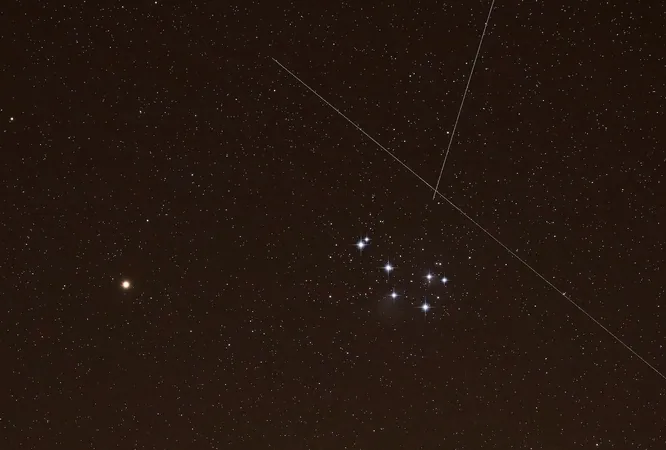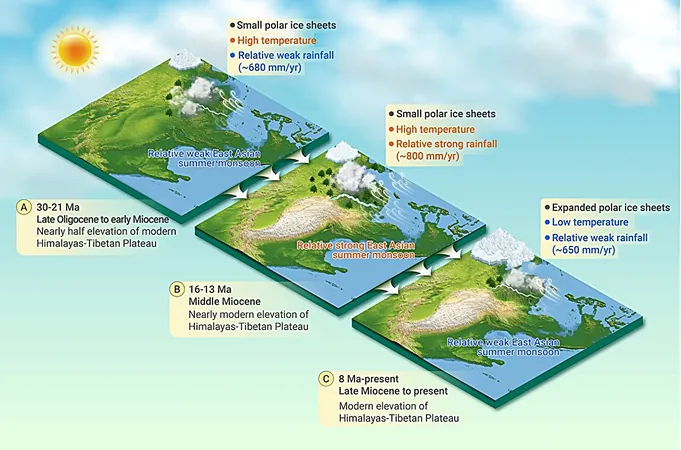
The Dark Side of the Sky: How Satellite Megaconstellations are Rewriting Our Cosmic View
2025-04-04
Author: Nur
Introduction
The night sky has always been a source of wonder and solace for humanity, a vast canvas where the brilliance of stars reminds us of our shared existence and the insignificance of our everyday troubles. Yet, the industrial revolution and urbanization have already marred this celestial beauty with light pollution. Now, a new wave of technology threatens to obliterate the serene darkness of our nights entirely: satellite megaconstellations.
The Rise of Satellite Megaconstellations
Since the dawn of the space age, there was an estimated 2,000 operational satellites orbiting Earth. However, in May 2019, everything changed dramatically when SpaceX launched its first batch of Starlink satellites, marking the onset of satellite megaconstellations. These networks comprise thousands of small satellites working in unison to provide global internet coverage. Currently, over 10,000 satellites are actively orbiting, with projections indicating there could be as many as 500,000 to a million in the next decade!
Alarming Growth
Astrophysicist Dr. James Lowenthal emphasizes the alarming speed at which the satellite population is growing, akin to a "hockey stick" curve—steady for decades, then experiencing exponential growth. SpaceX's plans alone envision deploying 40,000 satellites, and this is just one of over 200 projects vying for orbital space. Other countries, including India and China, are also pushing their satellite deployments, suggesting a significant shift in governance and ownership of what was once a largely public domain. Even Rwanda has ambitious proposals for up to 330,000 satellites!
Impact on Stargazing and Research
While these satellites have their advantages, such as improving global communications and monitoring climate change, they also present an array of problems to our night sky. Researchers have noted that as the number of these satellites increase, they could severely hinder stargazing experiences. As Dr. Lowenthal explains, satellites reflect sunlight similar to the moon, joining the already dimming stars in the night sky.
In addition to disrupting the beauty of our celestial sights, these swarms of shiny satellites could interfere with astronomical research. Not only do they disrupt images captured by telescopes, but they also emit radio frequency radiation, making it challenging for scientists to study cosmic phenomena. Indeed, previous astronomical discoveries have had to be retracted because they were mistakenly identified as satellites.
Environmental Concerns
The light pollution from these satellites is not the only environmental concern. There's a growing discussion around space debris, which poses a risk of collisions, thereby increasing the likelihood of even more space junk. Moreover, there are serious implications for atmospheric pollution, as rocket launches produce harmful emissions that contribute to climate change. Dr. Connor Barker of University College London highlights how rocket emissions could negate some environmental progress we've made in recent decades, emphasizing the double-edged sword that satellites present.
Need for Regulations
Current space governance frameworks, such as the U.N.’s Outer Space Treaty, do not adequately address the challenges of the modern space economy dominated by private enterprises. The regulations mainly focus on preventing contamination of celestial bodies and mitigating environmental impacts on Earth, but they fail to define measures against light pollution or other challenges posed by an increasing number of satellites.
The need for robust regulations is urgent. Agencies like the Federal Aviation Administration and Federal Communications Commission are currently balancing policy without a cohesive strategy to combat the negative impacts of satellite proliferation, especially those contributing to light pollution.
Conclusion
The stakes couldn't be higher. If we continue along this trajectory unregulated, we risk losing not only our view of the stars but also the valuable scientific insights they provide in understanding our universe. What once brought humanity together under a shared night sky faces the danger of being overshadowed by technology's relentless push towards connectivity.
Ultimately, our pursuit of progress must be balanced against our responsibility to protect the skies above us. As the age of megaconstellations dawns, we must advocate for and implement policies that safeguard our view of the universe, ensuring that future generations can also marvel at the wonders of the night sky. Are we prepared to watch the stars disappear before our very eyes? The decision lies in our hands.


 Brasil (PT)
Brasil (PT)
 Canada (EN)
Canada (EN)
 Chile (ES)
Chile (ES)
 Česko (CS)
Česko (CS)
 대한민국 (KO)
대한민국 (KO)
 España (ES)
España (ES)
 France (FR)
France (FR)
 Hong Kong (EN)
Hong Kong (EN)
 Italia (IT)
Italia (IT)
 日本 (JA)
日本 (JA)
 Magyarország (HU)
Magyarország (HU)
 Norge (NO)
Norge (NO)
 Polska (PL)
Polska (PL)
 Schweiz (DE)
Schweiz (DE)
 Singapore (EN)
Singapore (EN)
 Sverige (SV)
Sverige (SV)
 Suomi (FI)
Suomi (FI)
 Türkiye (TR)
Türkiye (TR)
 الإمارات العربية المتحدة (AR)
الإمارات العربية المتحدة (AR)